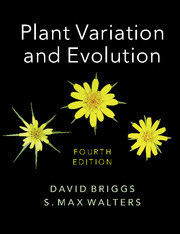Book contents
- Frontmatter
- Contents
- Preface to the Fourth Edition
- Acknowledgements
- Note on names of plants
- List of abbreviations
- 1 Investigating plant variation and evolution
- 2 From Ray to Darwin
- 3 Early work on biometry
- 4 Early work on the basis of individual variation
- 5 Post-Darwinian ideas about evolution
- 6 DNA: towards an understanding of heredity and molecular evolution
- 7 Breeding systems
- 8 Intraspecific variation and the ecotype concept
- 9 Pattern and process in plant populations
- 10 Pattern and process: factors interacting with natural selection
- 11 Populations: origins and extinctions
- 12 Species and speciation: concepts and models
- 13 Allopatric speciation and hybridisation
- 14 Abrupt speciation
- 15 The species concept
- 16 Flowering plant evolution: advances, challenges and prospects
- 17 Historical biogeography
- 18 The evolutionary impact of human activities
- 19 The taxonomic challenge ahead
- 20 Conservation: from protection to restoration and beyond
- Glossary
- References
- Index
5 - Post-Darwinian ideas about evolution
Published online by Cambridge University Press: 05 June 2016
- Frontmatter
- Contents
- Preface to the Fourth Edition
- Acknowledgements
- Note on names of plants
- List of abbreviations
- 1 Investigating plant variation and evolution
- 2 From Ray to Darwin
- 3 Early work on biometry
- 4 Early work on the basis of individual variation
- 5 Post-Darwinian ideas about evolution
- 6 DNA: towards an understanding of heredity and molecular evolution
- 7 Breeding systems
- 8 Intraspecific variation and the ecotype concept
- 9 Pattern and process in plant populations
- 10 Pattern and process: factors interacting with natural selection
- 11 Populations: origins and extinctions
- 12 Species and speciation: concepts and models
- 13 Allopatric speciation and hybridisation
- 14 Abrupt speciation
- 15 The species concept
- 16 Flowering plant evolution: advances, challenges and prospects
- 17 Historical biogeography
- 18 The evolutionary impact of human activities
- 19 The taxonomic challenge ahead
- 20 Conservation: from protection to restoration and beyond
- Glossary
- References
- Index
Summary
For forty years after the publication of the Origin, Darwin's ideas were a source of tremendous public controversy. For this reason he never received any awards from the state, although he was awarded honorary degrees and decorations in plenty. Despite thousands of critical sermons, many accepted Darwin's views on evolution, but, as seen in this chapter, the concept of natural selection was not generally accepted, until the rise of genetics in the mid-twentieth century. The biological literature of the period is full of papers speculating about the adaptive significance of various structures, the probable course of evolution in the plant and animal kingdoms, and so-called ‘evolutionary trees’ showing phylogenetic relationships (Fig. 5.1).
Some of this work is of lasting interest, but there was a depressing tendency in the later years of the period for armchair biologists to produce highly speculative theories, and there was a lack of critical experiment with living material. Towards the end of the century, however, there were signs of an increasing interest in the possibility of using experiments for the investigation of evolutionary problems.
Experimental investigation of evolution
A good example of this change in climate is provided by the controversy that enlivened the pages of Nature and the editorials of The Gardeners’ Chronicle in 1895. At a discussion meeting of the Royal Society, the Director of the Royal Botanic Gardens, Kew, W. T. Thiselton-Dyer, had shown specimens of the ‘feral’ type and cultivated variants of what he called Cineraria cruenta (now called Pericallis cruenta) – the gardener's Cineraria – and an extended account of his ideas was printed in Nature (1895). He suggested, as befitted an ardent and orthodox disciple of Darwin, that, as far as was known, the garden Cineraria was derived from Senecio (Cineraria) cruentus from the Canary Islands ‘by the accumulation of small differences’. Bateson (1895a, b) responded to this view in a lengthy letter to the editor, questioning the assertions of Thiselton-Dyer. Bateson concluded, after a study of the literature, that modern Cinerarias arose from hybridisation between several distinct species, that selection was practised on variable hybrid progeny, and that ‘sports’ may have been important, as well as subsequent improvements as a consequence of the selection of small-scale variation.
- Type
- Chapter
- Information
- Plant Variation and Evolution , pp. 67 - 73Publisher: Cambridge University PressPrint publication year: 2016



